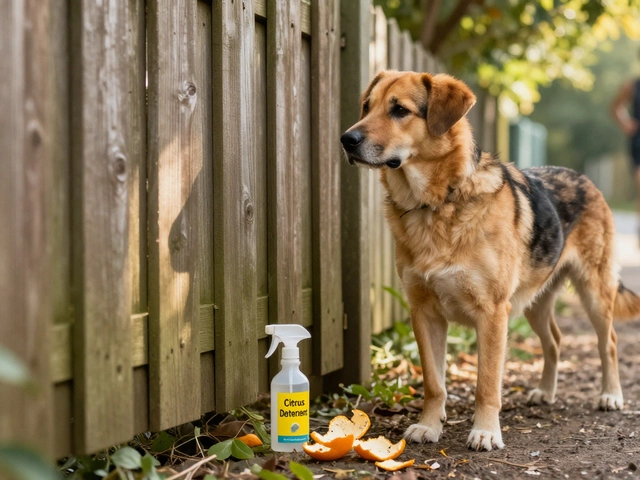Bet you never thought something in your fridge could spark heated debates in dog parks across the country. Greek yogurt—creamy, tangy, and loaded with protein—seems to show up everywhere: as a breakfast staple, sauce thickener, or afternoon snack. But what about your dog? Can this protein-packed treat actually do good, or is it a creamy mistake waiting to happen? Let’s crack open the facts and find out if this ancient food belongs in your dog's bowl.
Greek Yogurt and Dogs: What Makes It Different?
Greek yogurt is often tossed into recipes for its thick texture and tart flavor. But what actually puts it in a category of its own compared to regular yogurt—and why does that matter for your four-legged buddy? Greek yogurt is strained, meaning more whey (the watery part of milk) is removed, so you’re left with a denser, creamier snack that packs roughly twice the protein. For every 100 grams, Greek yogurt averages about 10 grams of protein, which is higher than plain yogurt. It’s also typically lower in sugar and lactose because much of that is strained out, which can be a big deal for some dogs that don't jive with dairy.
The protein boost helps build and repair muscles and supports your dog's immune system, especially helpful if you’ve got an energetic or senior pup at home. Greek yogurt’s probiotic content, mainly the Lactobacillus and Bifidobacterium strains, are loved for helping keep a dog's digestive system in working order. Probiotics restore balance in the gut after things like antibiotics, stress, or bad table scraps wreak havoc.
But not all Greek yogurt is created equal. Some brands, trying to please human taste buds, load up with sugars or toss in artificial flavors, which are a no-no for dogs. Stick to plain, unsweetened, and unflavored options. If your yogurt lists xylitol (a common low-calorie sweetener), put it back—xylitol is toxic for dogs and can seriously harm them, even in tiny amounts.
Greek yogurt also stands out for its lower lactose level, making it a bit easier on doggy stomachs compared to regular yogurt or milk. Still, don’t assume every pup will handle it like a champ; dogs lack the enzyme lactase as adults, so a few still react to dairy no matter what. Always keep an eye out for signs like gas, cramps, or loose stools after yogurt treats. And if your dog is allergic to milk protein (casein), steer clear entirely.
So, can dogs have Greek yogurt? The answer sits on a scale from sometimes-to-often, as long as the right kind and amount is served, and your individual dog isn’t one of the sensitive types.
Health Benefits: When Greek Yogurt Works for Dogs
There’s a reason why people started slipping Greek yogurt into frozen dog treats or mixing a dollop into their pup’s bowl. The probiotics inside Greek yogurt offer some real digestive benefits, especially for dogs struggling with mild tummy troubles. Studies from the last decade have shown that dogs given healthy blends of probiotics can see improved stool quality and a stronger immune response. The live cultures in Greek yogurt—such as Lactobacillus acidophilus—are known to help replenish good bacteria, which is crucial after your dog’s had antibiotics or a spell of diarrhea.
It’s not just the bugs at work. Greek yogurt is a great source of calcium and phosphorus, keeping bones and teeth healthy over the long haul. It’s got B vitamins, like B12, which helps with nerve and blood cell health, and riboflavin, which supports metabolism. That extra protein is also handy if you have an active or growing dog, or if your dog’s diet needs a little boost without piling on calories.
If your dog battles stinky breath or ear infections, Greek yogurt might even be a stealthy helper. The live cultures interfere with yeast overgrowth in the mouth and ears, creating a friendlier environment for good microbes. Anecdotes from veterinarians and dog parents point to yogurt’s ability to freshen breath and keep gunky ears at bay. Of course, this isn’t a substitute for the real vet-approved treatments, but think of it as a gentle background boost.
Greek yogurt’s creamy texture also works magic for picky eaters and helps hide medications. If your dog refuses pills, you can coat them in a yogurt shell and watch them disappear. Some mix a spoonful into dry food to make meals more enticing, especially when dogs are sick, anxious, or just plain bored with their food.
Curious about how Greek yogurt stacks up nutritionally? Take a look at this quick comparison table:
| Nutrition per 100g | Greek Yogurt (plain, low-fat) | Regular Yogurt (plain, low-fat) |
|---|---|---|
| Protein | 10g | 5g |
| Sugar | 3-4g | 6-7g |
| Calcium | 110mg | 120mg |
| Lactose | 2g | 4g |
That extra protein and reduced sugar can be a game-changer if you’re watching your dog’s waistline or managing conditions like diabetes. Keep in mind, though, Greek yogurt is a supplement, not a stand-in for complete dog food. Daily dog caloric needs vary—older, lazier dogs aren’t burning off extra calories, so portion sizes always matter.

When to Skip Greek Yogurt: Risks and Red Flags
Just because something is good for some dogs doesn’t mean it works for all. Some pups are more sensitive to dairy than others. If your dog’s never had yogurt, start with a tiny amount—like, barely a teaspoon—and watch for any signs of digestive upset within 12-24 hours. The most common red flags: gurgling stomach, diarrhea, gas, or visible discomfort. If you spot any of these, Greek yogurt probably isn't your dog’s soulmate snack.
Medical conditions make a huge difference here. Dogs with diagnosed lactose intolerance or dairy allergies should avoid all yogurt, not just Greek. Symptoms of a true dairy allergy include not just stomach trouble, but chronic itchy skin, hives, general discomfort, and sometimes repeated ear infections. If you notice these popping up after dairy, skip straight to your vet’s advice.
For dogs with pancreatitis or a history of obesity, even low-fat Greek yogurt can be too rich. The fat content—even at 2%—piles up quickly if treats turn into a routine. And don’t forget, the extra calories from 'healthy' add-ins add up fast. For diabetic pups, the natural milk sugar in Greek yogurt, though lower than regular yogurt, still counts, so keep close tabs and always ask the vet first.
The biggest risk comes from products with extras added for human tastes. Flavored yogurts can be a minefield: vanilla often contains sugar, and "fruit on the bottom" cups sometimes sneak in xylitol. Even small doses of xylitol can send a dog’s blood sugar plummeting, which can be deadly. Any sign of sudden vomiting, lethargy, or staggering—this needs emergency care, not just a treat ban.
If you’ve got a puppy at home (under six months), don’t rush into adding Greek yogurt just yet. Young puppies have different digestive enzymes and may not handle any dairy until they're older. Stick to puppy food unless your veterinarian specifically says otherwise.
How to Serve Greek Yogurt: Tips and Fun Ideas
Done right, Greek yogurt is a fun, healthy addition to your dog’s diet. The golden rule: plain, unsweetened, unflavored, and given in moderation. Think of it as a treat or a food topper, not a whole meal. If you’re introducing it for the first time, be conservative—start with a teaspoon for smaller dogs and a tablespoon for larger ones, and increase gradually if all goes well.
You can spoon a dollop over kibble or wet food to add flavor and texture. For a cool summer treat, freeze small spoonfuls of Greek yogurt in an ice cube tray—pop out a cube on a hot day or after a walk. Want to get creative? Mix in dog-safe fruits like blueberries or diced apples (skip grapes or raisins—they’re toxic). Freeze the blend into silicone molds for easy portioning and just the right hit of calcium and probiotics.
If you need to give your dog pills, try hiding them in a bit of Greek yogurt—it masks the taste and goes down smoothly. Just don’t use this trick for bitter-tasting meds without the vet’s say-so, as some medications shouldn’t be mixed with dairy at all. For dogs who bolt their food, stirring yogurt into their meal can slow them down and make every bite count.
Homemade Greek yogurt toppers are a hit among dog lovers. Mash together a spoonful of Greek yogurt, a teaspoon of pumpkin puree, and a sprinkle of ground flaxseed—spread this on a Lickimat or stuff it into a Kong toy. Not only does it make for a tasty distraction, but the combo of probiotics, fiber, and omega-3s covers a lot of health bases.
Just remember: treats, including Greek yogurt, should make up less than 10% of your dog’s daily calorie intake. Eyeballing isn’t enough; check the back of snack labels and tally up your dog’s daily food needs, adjusting accordingly. If you’re training your dog and using treats throughout the day, account for that in their main meal to avoid slow weight gain.
Here’s a quick checklist for serving Greek yogurt to dogs safely:
- Choose plain, unsweetened Greek yogurt.
- Check the ingredient list for xylitol and artificial sweeteners.
- Start with small amounts; monitor for reactions.
- Mix with dog-safe add-ins for variety.
- Skip for puppies under six months or dogs with dairy intolerance.
- Always include Greek yogurt as a treat, not a meal replacement.

Greek Yogurt Myths, Fun Facts, and What Vets Say
There’s a trend out there to dub Greek yogurt as a canine superfood. While the benefits are real, let’s clear up a few myths. First, Greek yogurt alone won’t “fix” aggressive stomach problems, chronic skin allergies, or behavioral issues. It can be a helpful add-on but not a replacement for proper treatment and vet care. Also, “all natural” doesn’t always mean safe for pets. Some boutique or local yogurts, for example, skip pasteurization—which can put your pup at risk for bacterial infections.
Veterinarians suggest that for dogs without dairy allergies or intolerance, Greek yogurt is usually safe and can support a healthy gut microbiome. In fact, a 2023 review said adding probiotic-rich dairy like Greek yogurt to a dog’s diet showed mild improvements in stool quality and immune markers, especially after antibiotic treatment. But remember, every dog reacts differently. If your dog has a sensitive tummy or medical issue, a chat with the vet comes before diet experiments.
Did you know that the tradition of cultured yogurt for pets dates back centuries? Farmers in Greece and Turkey commonly fed goats and working dogs the leftover yogurt whey, believing it gave them stamina and digestive strength. Modern science now backs up those old-school instincts about fermented foods and gut health.
If you’re wondering whether to offer other yogurts—think goat's milk yogurt or kefir—these can also be safe as long as they’re plain, low in sugar, and free of artificial sweeteners. Some dogs with cow dairy sensitivities do better on goat’s milk yogurt because it has a different protein structure and tends to be easier to digest. Always introduce slowly to check for any reaction.
For the curious minds, here’s an eye-opening stat: According to a 2024 pet wellness survey, about 41% of dog owners have given yogurt to their dog at least once. Among those, 84% chose greek yogurt for dogs specifically for its high protein and probiotic reputation. Yet less than 15% actually measured out the portion—most went with a “spoon and see” approach. A good reminder: even healthy snacks need boundaries.
The bottom line? Dogs can eat Greek yogurt—and, in many cases, they’ll even thrive on it. Just pay close attention to the label, portion size, and your dog’s unique needs. If in doubt, your vet will know what’s best. Just please, please, don’t share your flavored blueberry swirl.





